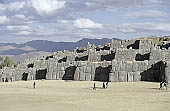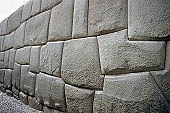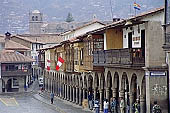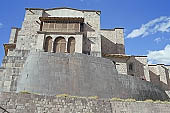| enter keyword to search: |
|
Images db
|
|
|
Articles db
|
|
|
|
|
| Incan Architecture of Peru |
|
|
|
Held to be the abode of the gods Cusco was founded in the 12th century by the first Inca Manco Capac, the mythical father of the royal Inca line and son of Sun God. The legendary origin of the Incas tells that the Sun created a man Manco Capac and his sister, Mama Occlo on an island in the azure waters of Lake Titicaca. The Sun, their father, gave them a golden rod with the order that whatever place the rod would sink into the earth that place shall be the home of his chosen people, the Quechua. At a hill overlooking a beautiful valley high in the Andes the rod disappeared into the earth designating the site were Cusco was founded.
Capital of Tahuantisuyo the great Inca Empire, conceived as a major administrative and ceremonial centre, Cusco was the heart of the Inca political system that controlled a large portion of South America. At the foot of the great pre-Inca fortress of Sacsayhuamán the Incas built palaces, squares, streets and public buildings that have survived through the centuries to this day. Following the Spanish conquest, unfortunately very little left of the original buildings, and today only some walls remains integrated in the colonial houses. Despite all the Spanish palaces and churches have been erected utilising the stones of the ancient Inca palaces (Sacsayhuaman has been used as quarry since 1950) what is left can still impress the visitor.

|
Cusco, Sacsayhuaman
|
The city plant
The plant of Cusco had a correspondence with the political and mythical vision of the Incas. Navel of the earth, it was the centre of Tahuantinsuyu (the Four Corners) and the four regions in which it was divided all radiated from Cusco. The city had the shape of a crouching Puma, considered as a special deity among the Quechuas. Sacsayhuaman fortress formed the head of the puma, Saphy and Tullumayo, the two rivers that bordered the city, unite in Pumaqchupan, the tail of the puma.
The astronomers planned a complex system of sanctuaries carefully aligned with stars and other astronomical points, to correspond to a gigantic calendar that would also have functions of social and festive organization.
The city was divided in two halves by the roads that went towards the Antisuyo and Contisuyo: 'Hanan Cusco' a modified form of 'Hawan Qosqo' (Upper Cusco) around the large central square and 'Urin Cusco' a modification of 'Uran Qosqo' (Low or Inferior Cusco) with the Koricancha temple.
The city had four sectors that corresponded to the four nations of Tawantinsuyo; each sector was further divided in three parts, resulting in the 12 districts into which the city was divided:
Qolqanpata or 'District of the Storages', currently San Cristóbal quarter
Kantupata or 'Kantu Flores District' (Kantu is the Peruvian national flower)
Pumakurko, or the 'Puma's backbone'
T'oqokachi or 'Salt lacking in substance', the main street currently located in San Blas;
Munay Senqa or the 'Pretty Nose' district, located at Recoleta;
Rimaq Pampa or the 'Talking Square', currently called Limaqpampa;
Pumaq Chupan or the 'Puma's Tail', located in front of the Savoy Hotel;
K'ayao Cachi or 'Salt Formation' in the Qoripata district;
Ch'akill Chaka, which corresponds to the current blocks of Santiago and Belen;
Piqchu, which still means 'summit or mountain'
K'illipata or 'District of the Kestrel' (k'illichu = sparrow's hawk) situated at Piqchu, Santa Ana district;
Wakapunku or 'Door of the Temple', which is currently the Saphi street.
The streets that today are Av. Sol, St. Romeritos, St. Loreto (Intiquillo), and St. San Agustin all of them converged at the small plaza called Intipampa in front of the Qorikancha the Temple of the Sun God. The temple was built on a natural hill over looking the rivers Saphy and Tullumayo; in its time it was the main Huaca shining in splendour, with its gold covered stones and a garden of golden plants.
Cusco |

|
The great square
The Saphi River, that today flows beneath the buildings in front of the Cathedral, divided into two sectors the great square of old Cusco. The "Ceremonial Sector" (Haukaypata), called also the Crying Sector, dominated by an enormous boulder covered with sheets of gold, was the place of the most important political and religious ceremonies. Kusipata or ‘joyfulness yard’ (now the Regocijo or Cabildo Square) was the other half of the Square. In the centre of these two sectors there was a special high platform known as 'Usnu' from where the Incas and priests or other officials spoke to the people. In the days of the Inca Empire, legend says that the ground of the great square was made up symbolically of earth brought from all the regions conquered by the Incas.
The most important buildings were located around the Square.
Inca Pachakuteq's palace known as Qasana, which nowadays makes a corner with the Plateros Street, stood out towards the northeast.
To the north, we could find the palace of Inca Roqa called Qoraqora.
In the area where the Cathedral is currently situated there was Kiswar Kancha: the palace of Inca Wiraqocha.
In front there was one Suntur Wasi,
To the east the Hatun Kancha, which belonged to Inka Yupanqui.
There is also the palace that today is called Hatunrumiyoq (whit the famous 12-angle stone), which belonged to Inka Roqa.
The Qollqanpata palace located in the San Cristóbal parish church was supposed to be property of Inca Manko Qhapaq the first mythical founder of Cusco.
The Amaru Kancha was the palace of Wayna Qhapaq and is currently occupied by the Society of Jesus, today surrounded by El Sol Avenue, Afligidos street and Loreto.
At Maruri street we still can see the wonderful walls of Pukamarka, the great block that comprises the streets Maruri, Pampa del Castillo, Plazoleta de Santo Domingo and Romeritos. Pucamarca was part of the religious infrastructure of the city.
At the west side, in front of the small square of Santo Domingo, was Morourco, in this house it was kept amaru urco, "the male snake", a long rope intertwined in four colours: black, white, red and tawny. During Cápac Raymi festivities dancers took it to the great square and leave it coiled on the floor as a snail. That dance was called Yanayra.

|
Cusco
|
The Acllahuasi (or Acllawasi the House of the Chosen Women or Sun Virgins).
The house of the acllas or selected ñustas was a large plot that began at Calle del Triunfo, in front of the Cathedral, and ended at Maruri Street. It was about 220 meters long, in a north-south direction, and 50 meters wide. The aqllawasi was located in the place that is currently occupied by the Church and the Monastery of the Dominican Nuns of Santa Catalina and many other private buildings near it. One of the most important building of Incan time, it was similar to a monastery for noble women. They were devoted to the worship of the god Sun, to prepare the Sacred Fire produced for the Inti Raymi, to knit the Inca's clothes and for different religious purposes like preparing the "Sanqhu" (ceremonial bread) and the "Aqha" or sacred "chicha" (corn beer). The virgins that lived in the Aqllawasi kept their virginity forever. All of them were educated by the "Mamakuna", who were priestess with skills regarding domestic and ceremonial matters. No men could see them, not even the Inca, just the "Qoya" (main wife of the Inca).
Cusco |

|
|
Related Pages
-
-
-
-
-
-
-
-
|
|
|
 |
|
|



